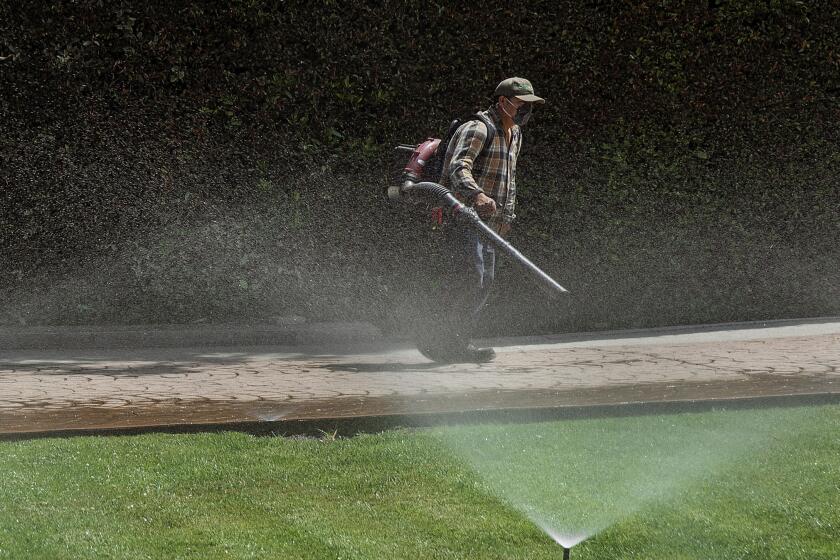Nothing says pretend like a palm tree
- Share via
PALM TREE, Palm tree, Palm tree. After two days of wrestling with his typewriter, those were the only words novelist John Fante’s fictional hero, Arturo Bandini, could muster. In Fante’s classic 1939 novel, “Ask the Dust,” Bandini arrives in Los Angeles with dreams of becoming a famous writer. He sees his first palm tree through the window of his dingy Bunker Hill hotel room, and though its trunk is blackened by automobile exhaust, it reminds him of Palm Sunday and Egypt and Cleopatra. Unable to write, he fixates on the tree outside his room and types its name “over and over across the page, up and down, the same words.” Writing that day was a battle, he thought, between him and the palm tree, and the palm tree won.
Nearly seven decades later, Los Angeles is finally fighting back, with a vengeance. A unanimous vengeance, that is. Two weeks ago, the City Council unanimously passed a motion to limit the planting of palms on city streets and medians. The city’s Department of Public Works has declared that the palm that Bandini found so alluring is not a tree at all but a lowly species of grass. City Council President Eric Garcetti’s office has proclaimed that the spindly yet exotic plants are “really bad for our city.” Paula Daniels, who heads Mayor Antonio Villaraigosa’s initiative to plant a million trees over the next five years, thinks oaks -- whose shade is better for water and air quality -- should replace aging palms when they die.
Others have defended L.A.’s palms on the grounds that they are emblematic of the city and give us a much-needed sense of place. I disagree. I’m standing up for palms because they say less about who we are and more about who we want to be. We’re talking aspirational vegetation. Rather than a sense of place, palm trees give us a sense of placelessness. They are a distraction, an indulgence, a whim. They are all about pretension. And, if nothing else, L.A. is among the most pretentious of cities.
I don’t say this dismissively. Look up “pretense” in your thesaurus and you’ll find synonyms such as “pretending,” “make believe” and “fantasy” -- all words that are, well, emblematic of our city.
But when I think of palm trees and pretense I don’t conjure images of Hollywood or Bel Air. I think of South L.A. and mid-Wilshire, where many of the nearly 30,000 palms that were planted as part of a beautification project in advance of the 1932 Olympics still reign.
Contemporary historians have much maligned the early Anglo city fathers who tried to market L.A. to freezing Easterners as a Mediterranean paradise. But the conflict between reality and fantasy is fundamental to the L.A. experience. The single-family homes from which rioters first emerged around Florence and Normandie on April 29, 1992, tell us that much of the frustration that fueled the riots arose out of relative rather than objective deprivation. Compared to the worst neighborhoods of Chicago or New York, the epicenter for the 1992 riots looks like paradise. Yet compared to the ideal of what L.A. should be, it is hell.
But our pretense cuts both ways. A juvenile probation officer in South L.A. once dragged me outside his office and pointed to the palm trees and the jumbo jets on the horizon.
“I point them out to the kids who come in here,” he told me. “I want them to know that people come to their city from all over the world to find their dreams.”
As they were for Bandini, palms can be evocative of exotic places and times. They lend themselves to imagination. When planted in rows, they can collectively look regal, but individually, the fan palm in particular can look downright Dr. Seussian. I love the funny-looking palms outside my apartment window, and I’ve often wondered why their tufts of unkempt fronds tilt toward the winds that come from the ocean.
I should have asked Leland Lai, the president of the Palm Society of Southern California, who walked me around his garden in Topanga one morning last week. Lai showed me some of the 300 species he has planted since he started collecting palms in 1970 as a way to combat his homesickness for his native Hawaii. Not at all the eccentric you’d expect, Lai is a mild-mannered businessman who thinks the city’s new stance on palm trees is excessive. He understands L.A.’s desire to create more shade by planting leafier trees, but he urges officials to try to find a balance between environmentalism and history, cost-efficiency and aesthetics.
As he walked me around the back of the house, to what appeared to be a tiny tropical rain forest, he articulated what it was that makes him love these plants. “They make you feel like you’re in a far-off exotic place,” he told me. “Palm trees take you away from Los Angeles.”






